 |
CHAMÄLEON + ONJALA OBSERVATORY Solar System | SITEMAP HOME CHAMÄLEON |
|
 |
|||
|
|
|||||||||||
 |
Mars, Jupiter and Saturn in
2020 Actually it was planned that one of us (Paech) should take planetary images from mid-February 2020 until the end of the Mars opposition on Onjala. Covid 19 put a "spanner in the works" of this planning. On March 25, Paech left Namibia and could not return until mid-October. Accordingly, the image results of Planet 2020 are " poor ". The rawavis were taken in October and November - in the Namibian summer. The seeing conditions were mostly bad, because due to the high solar radiation (daytime temperatures up to 38 degrees Celsius) the ground was extremely heated and cooled down only slowly. In addition, due to the onset of the rainy season, only a few evenings were cloudless. We show the best images 2020 of Mars, Jupiter and Saturn on a separate page. |
| On
June 25, 2019, the two planets Saturn and Pluto were close enough together to
be imaged in the field of view of a 200mm telephoto lens. Click here to load a large image version. Image Data: June 25, 2019, Canon EF 200mm at f/4, Canon EOS 60 DA uncooled, 25 x 300 seconds |
 |
 |
« On 10 June 2019,
Jupiter, with an apparent diameter of 46 arc seconds, was in opposition to
Earth. In addition, the cloud bands around the GRF and the GRF itself showed
massive changes from May onwards. Due to the extensive data material, we have
provided the image results
on a separate page. » Jupiter in near infrared, recorded on 10 July with a Ganymede transit. |
 |
| Jupiter with GRF and Ganymed, images taken on 4. Juni gegen
20:52 UT |
Jupiter with the moons Io and Kallisto, images
taken on 14. Juli gegen 18:35 UT |
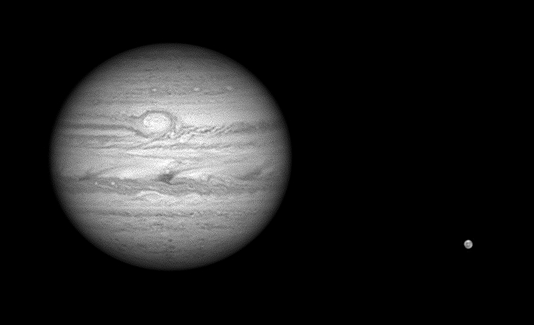 |
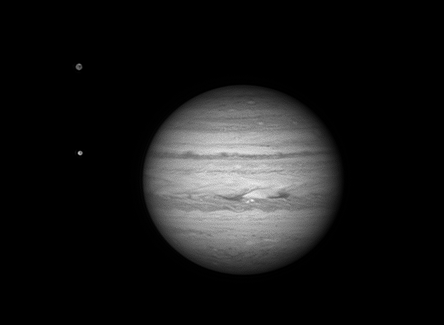 |
Saturn was actually not on our observation plan because of its small apparent diameter of only about 18 arc seconds. But with very good seeing we got some high-resolution images on August 30. Images in the primary focus of the C14, video module ZWO ASI 224C and Baader UV/IR blocking filter, 300 of 3,000 frames each. Both pictures can be enlarged by clicking on them.
| Saturn with its "Florring", imaged on 30. August at 17:20
UT |
Saturn and 6 Monde, imaged on 30.
August about 17:25 UT, Assembly of two images |
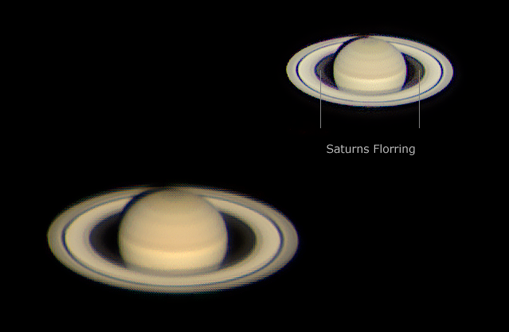 |
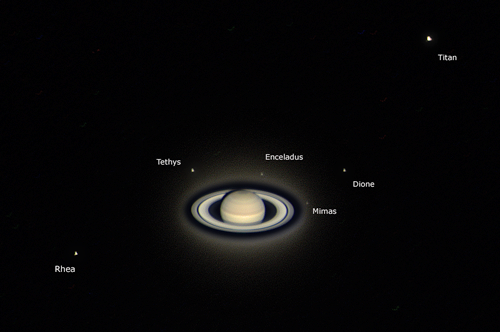 |
The raw avis files consisted - depending on the seeing conditions - of 2,000 or 2,500 single images of which 10% each were stacked. The acquisition time of the raw avis of 2,500 individual images was such that the Jupiter rotation was max. 0.4 arc seconds. Stacking software for the monochrome images was AviStack, the color images were processed with RegiStax. AviStack was used for sharpening and Photoshop CS2 for finishing.
In the Saturn images the Encke division becomes visible in segment. It will indicate a width of about 350 km, 0.05 arcseconds !!
Celestron SkyRis 445 Mono und Color (Pixelsize 3,75 mü) ZWO ASI 290 MM (Pixelsize 2,9 mü)
| July 29th, 2017: Jupiter (with GRF) and Saturn both
taken with Baader IrPass filter and Q-Turret Barlow lens element. Equivalent
focal length approx. 6,500 mm. Jupiter has an apparent diameter of 38 and Saturn of 18 arc seconds. In the left part of the Saturn ring a segment of the Enke division is visible. |
 |
 |
| August 9th, 2017: Jupiter in comparison between a focal
shot (f = 3,900mm) and a focal length of approx. 6,500mm with the Baader
Q-Turret Barlow lens. Apparent diameter of Jupiter was almost 35 arc seconds. |
 |
 |
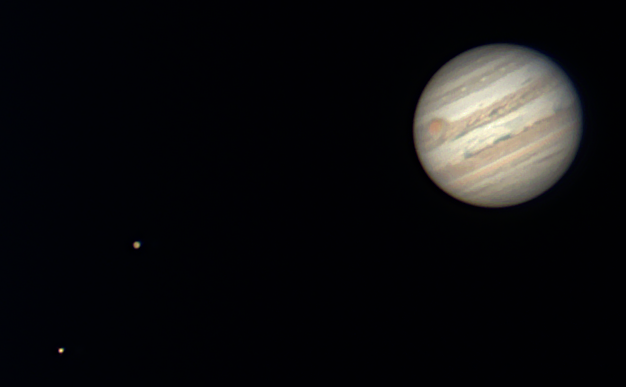 |
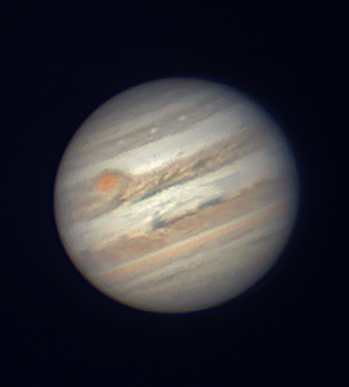 |
| August 11th, 2017: Jupiter in comparison between a focal length (f = 3,900mm) and a focal length of approx. 6,500mm with the Baader Q-Turret Barlow lens. |  |
 |
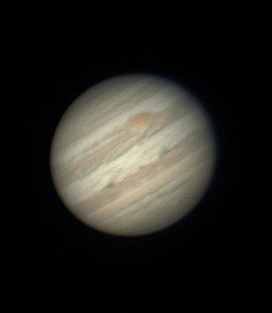 |
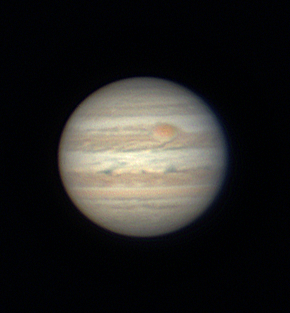 |
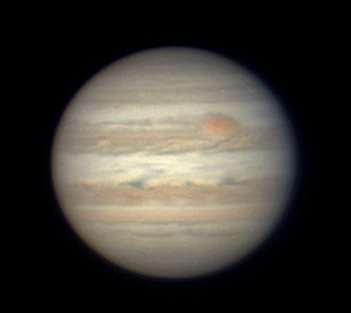 |
| August 13h, 2017: Jupiter with Ganymed and Io comparing
a monochrome and a color camera. Both shots with Baader Q-Turret Barlow, the monochrome shot with Baader IrPass filter. |
 |
 |
| August 14h, 2017: Jupiter in comparison between a focal lenght (f = 3,900mm) and a focal length of approx. 6,500mm with the Baader Q-Turret Barlow lens. |  |
 |
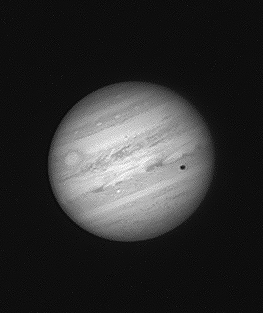 |
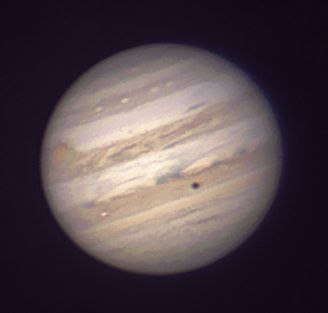 |
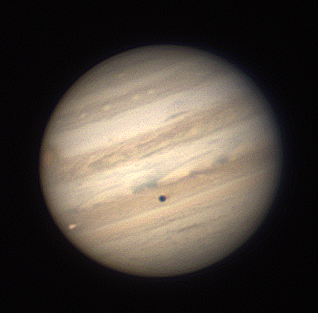 |
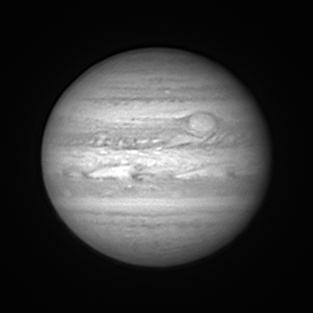 |
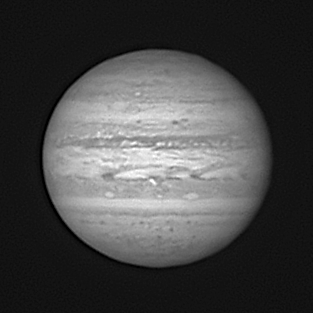 |
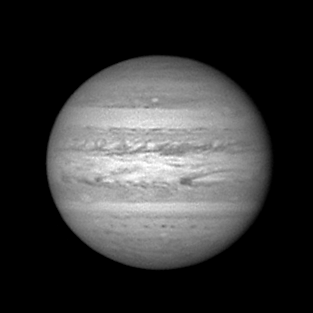 |
 |
 |
Saturn, taken with ZWO ASI 290 on the 20th of July (outside left) and
on the 23rd of July 2017 (left). In the Saturn images the Encke division becomes visible in segment. It will indicate a width of about 350 km, 0.05 arcseconds !! |
| Juni 2016 In June 2016 we
was testing a new videomodule, a ZWO ASI 290 MM with a pixel size of 2.9
microns. The image shows a comparison of Mars, Jupiter and Saturn at the same
scale, taken in the prime focus of the Celestron C 14 at june
2016. Stacking each 12% of 3.000 raw images. Image processing with AviStack 1.8 and Photoshop CS 2. More image information in the large image. Click here or on the thumbnail right to load the large version. |
 |
 |
Juni 2016 These collection of images shows a the
rotation of jupiter in a small time segment and also the movement of the moon
Europa tkane in the prime focus of our Celestron C14 at june 22. Camera was a
Celestron SkyRis 445 mono with addition of a Baader IR Passfilter. The image at lower right schows one of the raw image without any image processing. Stacking each 10% of 2.000 raw images. Image processing with AviStack 1.8 and Photoshop CS 2. More image information in the large image. Click here or on the thumbnail right to load the large version. |
 |
 |
 |
| Saturn 14.09.2015 | Saturn 14.09.2015 | Saturn 24.07.2015 |
 |
The
image at left shows the differnce in size (at the same scale) of saturn at 24.
July and 14. September due to the change in distance betwee earth and saturn.
Both images was taken in the prime focus of the Celestron C14 with a videomodule SkyRis 44 mono and a Baader IR Passfilter. Image addition each 300 of 3.000 raw images. |
These image of Saturn is the "First Light" planetary picture of the Celestron C14 after it was reassembled at Onjala lodge. The following pictures document our attempt to prove the Maxwell gap in the C-ring of Saturn photographically.
The picture below shows a mosaic of the NASA/Cassini cameras (from left to right you can see the D-, C-, B-, A- and F-ring). Click here to load a large version of the picture (copyright 2007 NASA/Cassini mission).

 |
For
this purpose the individual pictures of the Avistream were exposed longer than
usual. Specifications of the recordings: Date: 14. Mai 2013, 22:21 UT Instrument: Celestron Standard C14 + Baader Q-Turett Barlowelement, extension factor approx. 1.3 Focal length: ca. 5.200mm Ratio of aperture: ca. f/15 Camera: TIS DBK 21A F04.AS (Color) Location: Onjala Lodge/Namibia Summed up: 300/3.000frs Single frame exposure: 1/13 Sekunde Processing: AviStack 1.8, Photoshop CS2 (Scaling to 130% with Fitswork). Diameter of Saturn: 18.8" Distance to Earth: 1.32 x 10e9 km = 8.822 AE |

 |
The picture on the left shows a detail of the Cassini
mosaic containing the Maxwell gap. Using appropriate exposure times it should
be possible to detect the Colombo Gap with non-professional equipment. The
dimensions of the gaps are (#):
(#) Source: wikipedia |
 |
March, 21st 2014 - Saturn occultation by the moon in the morning
sky Whereas in Germany it was only a close encounter between moon and Saturn, in Namibia we were able to witness this event on March 21st of 2014 as a Saturn eclipse. The picture on the right shows a simulation with GUIDE. The ingress on the bright side of the moon was at 04:16:51 UT. The phase of the moon was waning, the age of the moon was 19.8 days and illumination was 80.4%. The egress was around 05:24 UT. A lot more and many pictures you can find here. ... « Click here to load a large picture. |
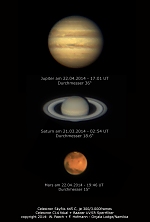 |
« Click here to load a large picture. |
 |
 |
 |
 |
 |
 |
 |
| Sun | Moon | Solar System | DeepSky | Widefield | Miscellaneous | Spec. Projects |
